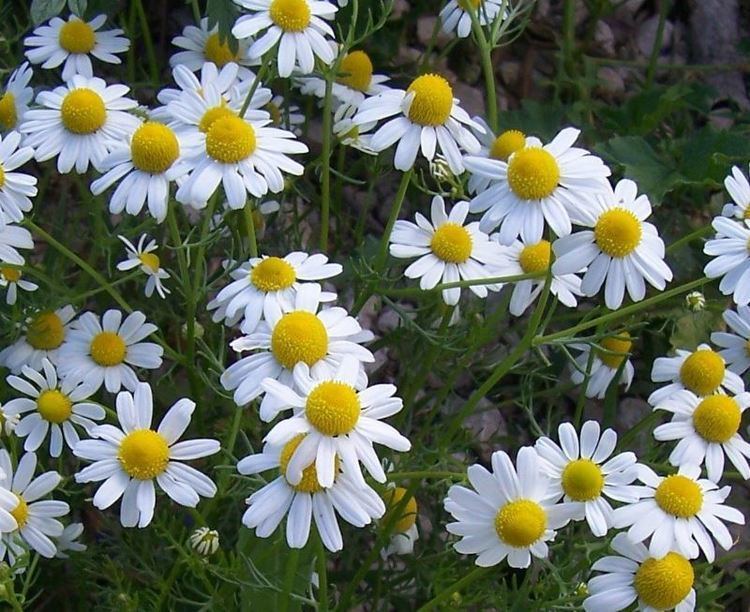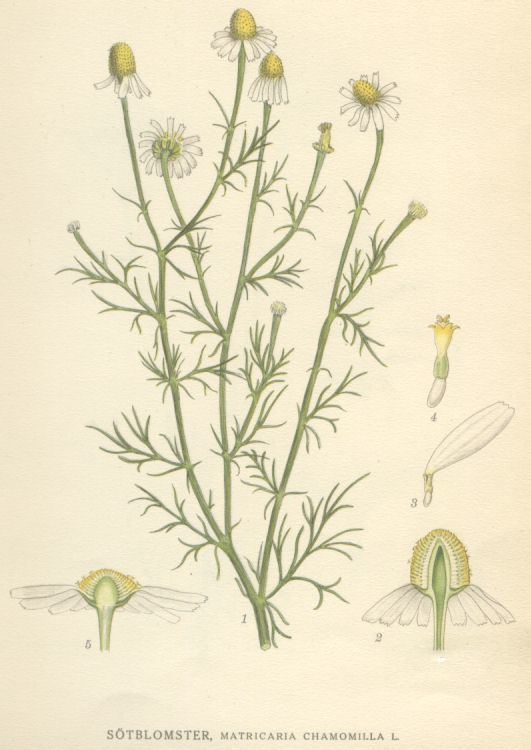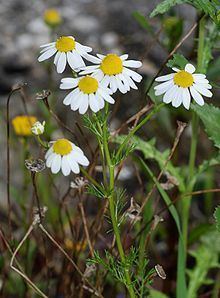Rank Species | Genus Matricaria Higher classification Matricaria | |
 | ||
Similar Matricaria, English marigold, Lemon balm, Roman chamomile, Yarrow | ||
Matricaria chamomilla (synonym: Matricaria recutita), commonly known as chamomile (also spelled camomile), Italian camomilla, German chamomile, Hungarian chamomile (kamilla), wild chamomile or scented mayweed, is an annual plant of the composite family Asteraceae. M. chamomilla is the most popular source of the herbal product chamomile, although other species are also used as chamomile.
Contents
- Etymology
- Description
- Distribution
- Herbalism
- Potential pharmacology
- Possible side effects
- Cultivation
- References

Etymology

The word chamomile comes from the Greek χαμαίμηλον (chamaimēlon) meaning "earth-apple", which is derived from χαμαί (chamai) meaning "on the ground" and μήλον (mēlon) meaning "apple". It is so called because of the apple-like scent of the plant.

Chamomile blue refers to chamazulene, the purified, deep-blue essential oil derived using steam distillation, rather than the plant itself.
Description

M. chamomilla has a branched, erect and smooth stem, which grows to a height of 15–60 cm (6–23.5 in). The long and narrow leaves are bipinnate or tripinnate.

The flowers are borne in paniculate flower heads (capitula). The white ray florets are furnished with a ligule, while the disc florets are yellow. The hollow receptacle is swollen and lacks scales. This property distinguishes German chamomile from corn chamomile (Anthemis arvensis), which has a receptacle with scales. The flowers bloom in early to midsummer, and have a strong, aromatic smell.
Distribution
M. chamomilla can be found near populated areas all over Europe and temperate Asia, and it has been widely introduced in temperate North America and Australia. It often grows near roads, around landfills, and in cultivated fields as a weed, because the seeds require open soil to survive.
Herbalism
German chamomile is used in herbal medicine for a sore stomach, irritable bowel syndrome, and as a gentle sleep aid. It is also used as a mild laxative and is anti-inflammatory and bactericidal. It can be taken as an herbal tea, two teaspoons of dried flower per cup of tea, which should be steeped for 10 to 15 minutes while covered to avoid evaporation of the volatile oils. The marc should be pressed because of the formation of a new active principle inside the cells, which can then be released by rupturing the cell walls, though this substance only forms very close to boiling point. For a sore stomach, some recommend taking a cup every morning without food for two to three months.
One of the active ingredients of its essential oil is the terpene bisabolol. Other active ingredients include farnesene, chamazulene, flavonoids (including apigenin, quercetin, patuletin and luteolin) and coumarin.
Dried chamomile has a reputation (among herbalists) for being incorrectly prepared because it is dried at a temperature above the boiling point of the volatile components of the plant.
Potential pharmacology
A 2006 review of the medical literature reported a number of beneficial effects for chamomile in in vitro and animal tests, but added more human clinical trials are needed before any firm conclusions can be drawn. Research with animals suggests antispasmodic, anxiolytic, anti-inflammatory and some antimutagenic and cholesterol-lowering effects for chamomile.
Possible side effects
Chamomile, a relative of ragweed, can cause allergy symptoms and can cross-react with ragweed pollen in individuals with ragweed allergies. It also contains coumarin, so care should be taken to avoid potential drug interactions, e.g. with blood thinners.
While extremely rare, very large doses of chamomile may cause nausea and vomiting. Even more rarely, rashes may occur. Type-IV allergic reactions (i.e. contact dermatitis) are common and one case of severe Type-I reaction (i.e. anaphylaxis) has been reported in a 38-year-old man who drank chamomile tea.
Cultivation
Soil type: German chamomile will tolerate many soils, but prefers a sandy, well-drained soil with a pH of 7.0-7.5 and full sun.
Cultivation: In gardens, plants should be spaced 15–30 cm (6–12 in) apart. Chamomile does not require large amounts of fertilizer, but depending on soil tests, small amounts of nitrogen, phosphorus, and potassium should be applied before planting.
The amounts of major nutrients that German chamomile needs for growing and reproduction are:
